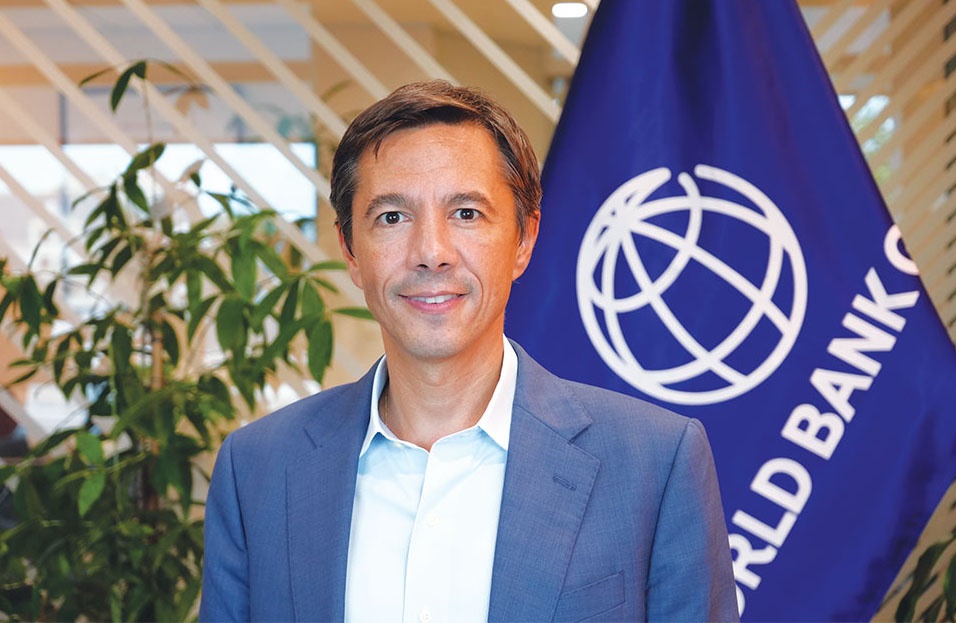The implications of global uncertainty
Price increases were large in sectors such as automobiles and transportation services, where pent-up demand picked up after reopening from the pandemic. On the supply side, shortages of key commodities, exacerbated by the Russia-Ukraine conflict, contributed substantially to higher energy and food prices.
 |
| Andrea Coppola, Lead economist, World Bank |
The higher share of food in consumer spending has caused inflation to accelerate more in low-income countries compared to other emerging markets and developing economies. Many countries experienced large currency depreciations that passed through into higher import, producer, and consumer prices.
In contrast, long-term inflation expectations have been more stable, edging up only slightly in both advanced economies and emerging markets and developing economies since the onset of the pandemic – by around 0.15 percentage points. This greater stability possibly reflects the credibility of the commitment of most central banks to confront inflation, reinforced by recent policy tightening.
After a period of easing monetary policy, multiple central banks in both advanced economies and emerging markets and developing economies reacted to inflationary pressures with interest rate hikes. In some countries, inflation was the result of supply shocks. In some others, like the United States, inflation was mainly driven by demand side factors.
Despite the heterogeneity of inflationary shocks, central banks’ response was homogeneous and synchronised. All the central banks acted at about the same time. Monetary policy response was synchronised but it was not coordinated. This lack of coordination triggers concerns of “monetary policy overdoing”. Let me elaborate on this concept. A central bank that raises interest rates to contain inflationary pressures hopes to slow its economy down
In a globalised world, that has effects not just at home as weakening demand will have an impact also abroad and particularly on trade partner countries. In this context, synchronised but not coordinated monetary tightening may lead to monetary policy overdoing.
What may happen in 2023?
In the US, continued macroeconomic policy tightening to contain inflationary pressures will compound the lagged effects of substantial interest rate increases in 2022 and further weigh on US activity, which is expected to stagnate in 2023. Inflation will moderate as labour markets soften and wage pressures dip.
In the Euro Area, due to ongoing energy supply shocks and substantially monetary policy tightening, a recession may materialise in the first half of 2023 before activity stabilises later in the year. Inflation is expected to gradually moderate as labour markets cool and assuming energy prices moderate.
In China, growth in 2023 should accelerate, reflecting a gradual lifting of pandemic restrictions that boost consumer spending. However, this acceleration will be hampered by the persistence of some pandemic-related restrictions, weak external demand, and also protracted weakness in the real sector.
Finally, in emerging market and developing economies, growth will be affected by tight financing conditions and weak external demand. High prices for food, energy, and other inputs may remain a burden for households and businesses in many developing countries.
Given already weak global growth, additional negative shocks may push the global economy into recession in 2023. There are five main sources of risk that may materialise during the next months. First is additional monetary tightening. Global inflation may be pushed higher by renewed supply shocks. If inflation remains above target, central banks will likely raise interest rates more quickly and to higher levels than currently expected, and keep them elevated for longer, to re-anchor expectations and return inflation to target.
Secondly, in a global economy characterised by slowing growth and rising borrowing costs, the growing pressures on emerging markets and developing economies in terms of capital outflows, currency depreciation, and difficulty servicing debt could result in currency crises or widespread private and public defaults, with potential cross-border spillovers.
Next, weaker-than-expected activity in China amid pandemic-related disruptions and stress in the real estate sector would add further headwinds to global activity, with adverse spillovers to commodity markets and global trade, particularly for countries integrated into China supply chains.
Furthermore, geopolitical tensions led some countries to re-orient supply chains such that key inputs are produced either domestically or with a narrow set of partners. Geopolitical turmoil could lead to a new wave of production disruptions and higher prices for globally traded goods.
Lastly, the global climate may be approaching “tipping points” at which changes accelerate in damaging ways, inflicting substantial human costs, damaging infrastructure, and disrupting activity. If one or more of these risks materialise, we may be heading towards a global recession in 2023.
Policy implications
Weak global economic outlook and heightened risks may have significant implications on the Vietnamese economy in terms of exchange rate pressures, financial sector vulnerabilities, higher inflation and slower economic growth in 2023. Authorities have a very difficult task and a crucial role to play to mitigate the impact on the Vietnamese economy and transform this challenging situation in an opportunity to modernise and further strengthen economic management and promote macroeconomic stability and economic growth.
Let’s start with monetary and financial policies. To address persistent exchange rate pressures generated by additional monetary tightening in the US, the State Bank of Vietnam (SBV) could consider allowing further flexibility in the exchange rate, including through a quicker pace of devaluation of the reference rate. Given the persistence of exchange rate pressures, direct foreign exchange sales could be used very cautiously to preserve international reserves. In case faster depreciation leads to a significant increase in inflation and inflation expectations rise, the SBV could consider using again the reference interest rates.
However, policy room is limited as interest rates are already high. Close coordination between monetary and fiscal policy would help to minimise further increases of the interest rates. In medium term, authorities could modernise Vietnam monetary policy by promoting a gradual transitioning towards an inflation targeting regime. To address liquidity challenges in the banking sector, in case some banks become more vulnerable and require support, the SBV could help to restore confidence by providing emergency liquidity assistance provided that banks have a plan in place to restore a satisfactory liquidity position, without continuous reliance on SBV lending.
In the mid term, Vietnam’s bank resolution framework could be enhanced to aid financial stability and a consolidated supervision framework could be strengthened to effectively monitor and assess systemic risks across markets, including banking, capital markets and higher-risk sectors such as real estate.
As for fiscal policy, the main challenge in 2023 will be to find a way to keep promoting economic growth in an inflationary context. As mentioned, fiscal and monetary policy coordination will be critical to manage the trade-off between growth and inflation objectives. Authorities may consider reining in public expenditure while prioritising human capital development and accelerating the implementation of selected public investments with the highest expected impact on economic growth.
Strengthening mechanisms that prioritise and evaluate the efficacy of public projects can enhance efficiency of public spending. Policies that aim at strengthening public procurement practices, administrative capacity, and transparency can also bolster public investment efficiency, foster a more favourable business climate for private investment, and help reinvigorate productivity.
Public investment management efficiency could also be improved by further strengthening project quality at entry and costs and benefits estimation, including when considering land acquisition and resettlement costs. In case further shocks require providing fiscal support to protect most vulnerable households, targeted transfers would be more effective and create less inflationary pressures than untargeted tax cuts or subsidies.
It is necessary to underscore the importance of structural policies to continue strengthening Vietnam long-term growth. To promote productivity, structural policies can promote a more efficient use of Vietnam’s assets: its productive capital, human capital, and natural capital. To promote an efficient allocation of capital, encouraging competition and easing firm entry and exit will help resources flowing to the most innovative and productive firms. It is also essential to promote a supportive business environment that allows productive firms to get access to finance and it is founded on transparent regulations and legal protections.
When it comes to human capital, Vietnam scores well on basic education, but advanced university level and vocational-technical skills are under-supplied. Skills upgrading will raise wages and boost domestic consumption.
Finally, addressing environmental-and climate-related challenges is a priority in Vietnam’s socioeconomic development strategy. Sound investments aligned with climate goals in priority areas such as transport and energy, climate-smart agriculture and manufacturing, and land and water systems, can all boost long-term growth, while also enhancing resilience to climate change and natural disaster. (First presented at the Vietnam Economics Forum, December 2022)
 | Vietnamese investors changing strategies to combat inflation Around 80 per cent of local investors are more actively managing their wealth and making changes to their investment strategies, according to Standard Chartered’s latest Wealth Expectancy Report. |
 | Limited inflation pressures underpin positive projections Vietnam has made a go of bringing inflation under control in 2022 thanks to the government’s great efforts to rein in market prices, with praise from various international organisations. |
What the stars mean:
★ Poor ★ ★ Promising ★★★ Good ★★★★ Very good ★★★★★ Exceptional
Related Contents
Latest News
More News
- Tax sector wraps up 2025 and sets priorities for next year (December 25, 2025 | 14:00)
- Masan Consumer officially lists on HSX, marking the next phase of value creation (December 25, 2025 | 13:20)
- Central Retail refocuses Vietnam strategy with Nguyen Kim exit (December 24, 2025 | 15:01)
- Three-way partnership unveiled to ease financing at Hong Hac City (December 24, 2025 | 14:13)
- Strengthening supply chains through trade promotions and customs reform (December 24, 2025 | 14:00)
- MCH to become the largest consumer stock on VN-Index (December 24, 2025 | 11:05)
- SCG initiative addresses social inclusion and inequality (December 24, 2025 | 09:18)
- Amata to develop $185 million Amata City Phu Tho (December 23, 2025 | 17:49)
- A tipping point for digital and hybrid wealth management in Vietnam (December 23, 2025 | 13:33)
- JustCo expands business into Vietnam (December 22, 2025 | 17:58)

 Tag:
Tag:



















 Mobile Version
Mobile Version